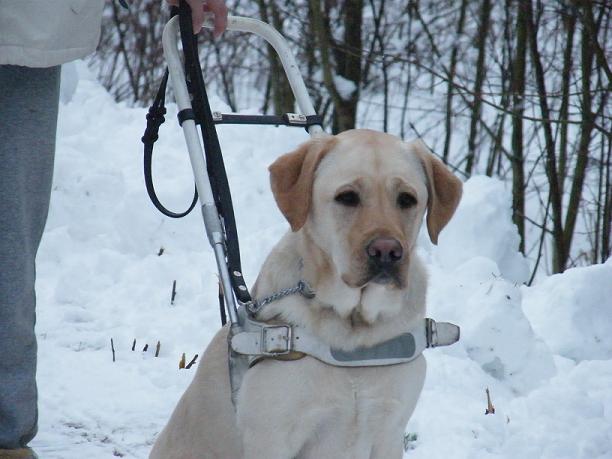mobility assistance dog on:
[Wikipedia]
[Google]
[Amazon]


 A mobility assistance dog or mobility service dog is a dog trained to assist a
A mobility assistance dog or mobility service dog is a dog trained to assist a
U.S. Department of Justice, Civil Rights Division. Mobility assistance dogs can have significant positive impacts on the lives of their handlers. Some larger-statured dogs with sound joints are trained to pull individuals in wheelchairs, and wear a type of harness specifically designed for pulling. However, wheelchair pulling remains controversial. Many US programs limit "wheelchair pulling" to short straight distances, most commonly for assistance getting in and out of a crosswalk. One study has found that using the traction provided by the service dog has physical benefits because manual wheelchair users can operate their chairs with less effort. Another type of mobility assistance dog task is "counter-balance". They are used for


 A mobility assistance dog or mobility service dog is a dog trained to assist a
A mobility assistance dog or mobility service dog is a dog trained to assist a physically disabled
A physical disability is a limitation on a person's physical functioning, mobility, dexterity or stamina. Other physical disabilities include impairments which limit other facets of daily living, such as respiratory disorders, blindness, epilepsy ...
person who has mobility
Mobility may refer to:
Social sciences and humanities
* Economic mobility, ability of individuals or families to improve their economic status
* Geographic mobility, the measure of how populations and goods move over time
* Mobilities, a conte ...
issues, such as poor balance or being a non-ambulatory wheelchair user. Roles include "providing balance and stability" picking up and carrying objects, pulling wheelchairs, opening and closing doors, and operating light switches."Commonly Asked Questions about Service Animals in Places of Business"U.S. Department of Justice, Civil Rights Division. Mobility assistance dogs can have significant positive impacts on the lives of their handlers. Some larger-statured dogs with sound joints are trained to pull individuals in wheelchairs, and wear a type of harness specifically designed for pulling. However, wheelchair pulling remains controversial. Many US programs limit "wheelchair pulling" to short straight distances, most commonly for assistance getting in and out of a crosswalk. One study has found that using the traction provided by the service dog has physical benefits because manual wheelchair users can operate their chairs with less effort. Another type of mobility assistance dog task is "counter-balance". They are used for
Parkinson's disease
Parkinson's disease (PD), or simply Parkinson's, is a long-term degenerative disorder of the central nervous system that mainly affects the motor system. The symptoms usually emerge slowly, and as the disease worsens, non-motor symptoms becom ...
and multiple sclerosis patients, along with other disorders and conditions. The handler does not put full weight on the dog. However, the dog can greatly assist a person with their gait and balance while walking. It can also be helpful for those with symptoms of proprioceptive
Proprioception ( ), also referred to as kinaesthesia (or kinesthesia), is the sense of self-movement, force, and body position. It is sometimes described as the "sixth sense".
Proprioception is mediated by proprioceptors, mechanosensory neurons ...
sensory loss, such as an inability to walk in a straight line.Thomson, Philip D (2004). "Gait Disorders". In Bradley, Walter George et al. ''Neurology in Clinical Practice: Principles of Diagnosis and Management, Volume 1''. Philadelphia: Butterworth Heinemann. pp. 324-326. These dogs usually wear a special vest so that the owner can attach a cane-like handle. This allows the dog to guide the owner and assist with their balance.
See also
*References
{{DEFAULTSORT:Mobility Assistance Dog Assistance dogs